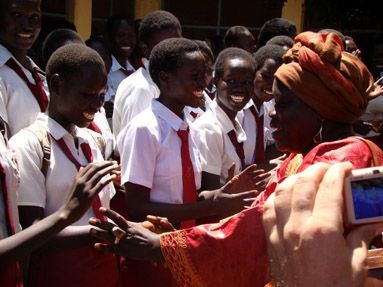South Sudan: Cultural attitudes, beliefs hindering girls’ education
June 1, 2010 (JUBA) — Jane Aketch remembers the struggle to achieve education all too well. For four years, she fought with her parents to allow her to attend primary education.

“My parents didn’t approve of us going,” she explained, shyly looking away in the opposite direction.
Though her parents wanted their five daughters to be literate, female education was never deemed particularly important in her village.
“Girls in Jonglei are supposed to stay at home and clean, while boys attended school,” Aketch said.
The need to attain universal primary education is one of the eight Millennium Development Goals (MDGs) expected to be achieve by 2015. But it appears realizing this could be a myth than reality.
In April 2006, the Government of Southern Sudan in partnership with UN Children’s Fund lauched the ‘Go to School’ campaign; an education for all initiative aimed at boosting primary school enrolment, especially among girls.
As part of this intiative, however, UNICEF played an instrumental role in school capacity-building though not only supporting construction works, but also training teachers at various levels.
“The initiative [‘Go to School’] was instrumental in increasing primary school enrolment especially among the girls. In some cases, teachers were trained on how to handle the girl child in schools,” Mr. Bismark Swangin, UNICEF’s Communication Officer for Southern Sudan Area Programme said.
WIDER GENDER GAP
An estimated 340,000 children, says UNICEF, were enrolled in primary schools at the time Sudan’s Comprehensive Peace Agreement was signed in 2005. In 2009, primary school enrolment was earmarked at 1,362,941 (860,878 boys and 502,063 girls).
According to UNICEF, however, access to education still remains one of the biggest challenges facing children in South Sudan, especially among girls.
Nearly half of primary school age girls do not go to school, a revelation likelty to hamper the success of the girl-child education policy initiated by the semi-autonomous regional government.
SOCIO-CULTURAL VERSUS ECONOMIC FACTORS
Girls’ education is a highly gender-sensitive issue, Mr. Bismark maintains, citing cultural factors like gender specific roles, early marriage, segregation between the sexes, and poverty as the primary barriers.
“This has resulted into gender inequality in education, with human development indicators for female literacy and the net enrolment ratio for females still low,” he said.
A 2008 study conducted by UNICEF on the socio-economic barriers to education in South Sudan, cited unfriendly environment of some schools, where students experience sexual harassment, early pregnancy, and child-to-child violence as some of the major obstacles to promotion of girls’ education.
The study, based on findings from the 2006 Rapid Assessment of Learning Spaces, further raised questions on constraints to key human resources, including poorly educated and trained staff handling expanding class sizes, limited supervision at county and state levels, and poor motivation causing teachers to quit the profession.
As such, low female participation in education was mainly attributed to several socio-cultural factors, citing the tradition of early marriage in rural areas, reluctance of many parents to send girls to mixed gender schools and the negative social attitudes towards girls’ education.
“Our communities have to start valuing the importance of educating the girl-child child. Too much attachmnet to some of the cultural norms that are negative towards girls will remain a set-back to the girl-child education policy,” Dr. Julia Duany, Undersecretary in the Ministry of Parliamentary Affairs in the Government of Southern Sudan observes.
On the hand, some headteachers attribute non-availability of female teachers in some schools as a major factor prompting parents to keep their girls away from school.
“We have many schools here, but even if the schools exist, most ot them often lacked basic amenities like essential for effective running of the school,” Sarafina Ladu, a teacher in one of the government-aided schools told Sudan Tribune.
RAY OF HOPE
In April 2000, a partnerhip of various organizations lauched the United Nations Girls’ Education Initiative (UNGEI), an initiative aimed at narrowing the gender gap in primary and secondary education.
UNGEI seeks to ensure that, by 2015, all children complete primary schooling, with girls and boys having equal access to free, quality education.
As to whether the new initiative will achieve its aims it yet to be seen. Only time will tell.
(ST)
